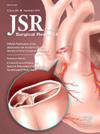白金一小时急诊科住院时间与创伤患者的治疗效果。
IF 1.8
3区 医学
Q2 SURGERY
引用次数: 0
摘要
简介:创伤室和急诊科(ED)的住院时间(LOS)是衡量病人护理的重要时间指标。有关这一主题的数据尚无定论或仅针对一种情况。我们的目标是确定急诊室住院时间与创伤患者的预后或死亡率之间的关系。我们试图研究影响这种关系的某些辅助因素。我们假设急诊室持续时间与中度和重度创伤患者的不良预后和死亡率相关:2018年6月至2022年6月,我们在一级创伤中心进行了一项回顾性研究。研究对象包括≥18 岁的重创患者。转入或转出、到达前死亡或从急诊室出院的患者均排除在外。根据处置时间进行单变量和多变量统计分析。主要结果是死亡率:六千七百八十一名患者符合纳入标准。根据处置时间≤60分钟(n = 521)和>60分钟(n = 6260)对患者进行了分层。≤60分钟组比>60分钟组年轻(53(四分位间距(IQR)30-73)对68(IQR 48-82),P 60分钟组)。≤60分钟组也更有可能接受血液制品(39.92%(n = 208)对 13.15%(n = 823),P 60分钟组)。发现≤60 分钟组比 >60 分钟组的死亡风险更高(17.47%(n = 91)对 2.75%(172),P 结论:急救时间缩短的创伤患者死亡率更高,这与我们的假设相反。ED LOS 缩短的患者伤势也更严重。无论在医院的哪个位置,创伤患者都能得到相同水平的护理,这也许是合理的。本文章由计算机程序翻译,如有差异,请以英文原文为准。
Platinum Hour: Emergency Department Length of Stay and Trauma Patients’ Outcomes
Introduction
Trauma bay and emergency department (ED) length of stay (LOS) are important time measures in patient care. The data on this subject are inconclusive or specific to one condition. Our goal was to determine the relationship between ED LOS and outcomes or mortality of trauma patients. We sought to investigate certain cofactors which influence this relationship. We hypothesized that ED LOS will be correlated with negative patient outcomes and mortality for moderately and severely injured trauma patients.
Methods
A retrospective study was conducted from June 2018 to June 2022 at our level 1 Trauma center. Patients ≥18 y that arrived as a trauma activation were included. Patients were excluded if they were transfers in or out, expired before arrival, or were discharged from the ED. Univariate and multivariable statistical analysis based on disposition time were performed. The primary outcome was mortality.
Results
Six thousand seven hundred eighty-one patients met the inclusion criteria. Patients were stratified based on time to disposition ≤60 (n = 521) and >60 min (n = 6260). The ≤60-min group was younger than the >60-min group (53 (interquartile range (IQR) 30-73) versus 68 (IQR 48-82), P < 0.001), and was more often male (69.48% (n = 362) versus 50.32% (n = 3150), P < 0.001). The ≤60-min group had a lower Glasgow Coma Scale (14 (IQR 8-15) versus 15 (IQR 15-15), P < 0.001), a longer intensive care unit LOS (2 (IQR 1-5) versus 1 (IQR 1-3), P < 0.001), a longer hospital LOS (4 (IQR 1-10) versus 3 (IQR 2-6), P < 0.001), and a greater Injury Severity Score (13 (IQR 5-22) versus 5 (IQR 4-10), P < 0.001) compared to the >60-min group. The ≤60-min group was also more likely to receive blood products (39.92% (n = 208) versus 13.15% (n = 823), P < 0.001) compared to the >60-min group. A greater risk of mortality was found in the ≤60-min versus >60-min group (17.47% (n = 91) versus 2.75% (172), P < 0.001). The ≤60-min group had a shorter transport time (14 (IQR 8-21) versus 17 (IQR 11-24), P < 0.001). On multivariable analysis, there was an association between a disposition time of 60 min or less and a decreased risk of mortality. However, men had a greater risk of mortality compared to women. Patients that received blood products and patients with more severe injuries had a higher likelihood of mortality.
Conclusions
Trauma patients with a decreased ED LOS had a higher rate of mortality, contrary to our hypothesis. The patients with a decreased ED LOS were also more severely injured. It may be reasonable that trauma patients can receive the same level of care regardless of location in the hospital.
求助全文
通过发布文献求助,成功后即可免费获取论文全文。
去求助
来源期刊
CiteScore
3.90
自引率
4.50%
发文量
627
审稿时长
138 days
期刊介绍:
The Journal of Surgical Research: Clinical and Laboratory Investigation publishes original articles concerned with clinical and laboratory investigations relevant to surgical practice and teaching. The journal emphasizes reports of clinical investigations or fundamental research bearing directly on surgical management that will be of general interest to a broad range of surgeons and surgical researchers. The articles presented need not have been the products of surgeons or of surgical laboratories.
The Journal of Surgical Research also features review articles and special articles relating to educational, research, or social issues of interest to the academic surgical community.

 求助内容:
求助内容: 应助结果提醒方式:
应助结果提醒方式:


